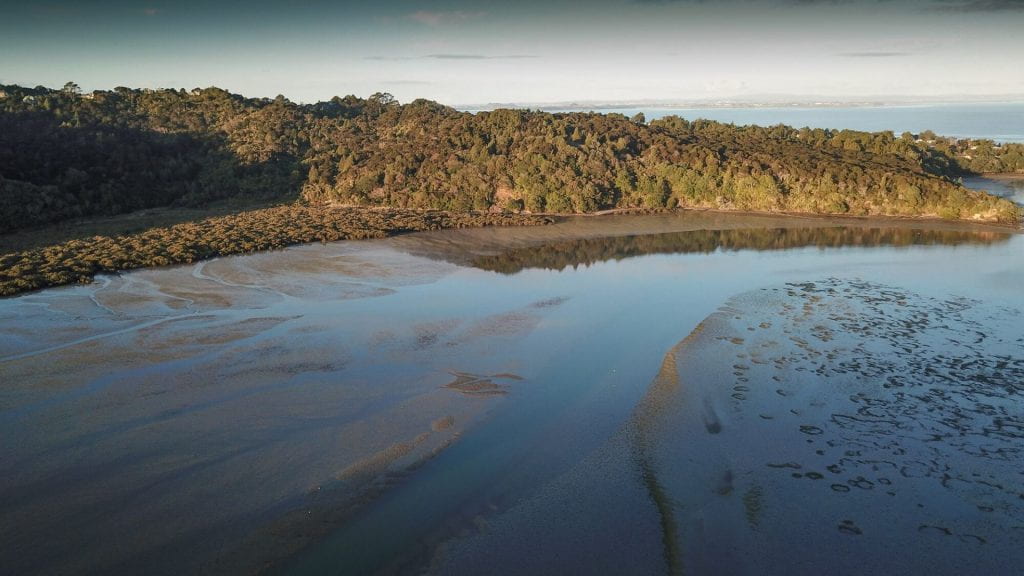We use flumes to study the sedimentary processes that take place when individual grains (sediment) and water transform concurrently, dynamically and interactively. One of my main research interests is in sediment pattern characterisation, such as ripples and dunes, which are commonly observed at beaches. Understanding the way sediment patterns (ripples, dunes, clusters, to name a few I have studied) form and evolve is important as it directly changes the flow above the riverbed, a region which is a natural aquatic habitat to many living flora and fauna. Experimental data are also needed to be incorporated into computational models, as the models allow running simulations at various scales, with experiments often concentrating on one scale.
Selected Publications:
![]() Terwisscha van Scheltinga, R.C., Coco, G. and Friedrich, H. (2019). Sand particle velocities over a subaqueous dune slope using high-frequency image capturing. Earth Surface Processes and Landforms https://doi.org/10.1002/esp.4617
Terwisscha van Scheltinga, R.C., Coco, G. and Friedrich, H. (2019). Sand particle velocities over a subaqueous dune slope using high-frequency image capturing. Earth Surface Processes and Landforms https://doi.org/10.1002/esp.4617
![]() Groom, J., Bertin, S., and Friedrich, H. (2019). Moving-window detrending for grain-roughness parameterization. Journal of Hydraulic Engineering https://doi.org/10.1061/(ASCE)HY.1943-7900.0001612
Groom, J., Bertin, S., and Friedrich, H. (2019). Moving-window detrending for grain-roughness parameterization. Journal of Hydraulic Engineering https://doi.org/10.1061/(ASCE)HY.1943-7900.0001612
![]() Groom, J. and Friedrich, H. (2019) Spatial structure of near-bed flow properties at the grain scale. Geomorphology https://doi.org/10.1016/j.geomorph.2018.10.013
Groom, J. and Friedrich, H. (2019) Spatial structure of near-bed flow properties at the grain scale. Geomorphology https://doi.org/10.1016/j.geomorph.2018.10.013
![]() Groom, J. and Friedrich, H. (2018) Bridging the lab-field interface in fluvial morphology at patch-scale: Using close-range photogrammetry to assess surface replication and vegetation influence. River Research and Applications https://doi.org/10.1002/rra.3370
Groom, J. and Friedrich, H. (2018) Bridging the lab-field interface in fluvial morphology at patch-scale: Using close-range photogrammetry to assess surface replication and vegetation influence. River Research and Applications https://doi.org/10.1002/rra.3370
![]() Groom, J., Bertin, S., and Friedrich, H. (2018). Evaluation of DEM size and grid spacing for fluvial patch-scale roughness parameterisation. Geomorphology https://doi.org/10.1016/j.geomorph.2018.08.017
Groom, J., Bertin, S., and Friedrich, H. (2018). Evaluation of DEM size and grid spacing for fluvial patch-scale roughness parameterisation. Geomorphology https://doi.org/10.1016/j.geomorph.2018.08.017
![]() Groom, J., Bertin, S. and Friedrich, H. (2018). Assessing intra-bar variations in grain roughness using close-range photogrammetry. Journal of Sedimentary Research https://doi.org/10.2110/jsr.2018.30
Groom, J., Bertin, S. and Friedrich, H. (2018). Assessing intra-bar variations in grain roughness using close-range photogrammetry. Journal of Sedimentary Research https://doi.org/10.2110/jsr.2018.30
![]() Bertin, S. and Friedrich, H. (2018). Effect of surface texture and structure on the development of stable fluvial armors. Geomorphology, 306, 64-79. https://doi.org/10.1016/j.geomorph.2018.01.013
Bertin, S. and Friedrich, H. (2018). Effect of surface texture and structure on the development of stable fluvial armors. Geomorphology, 306, 64-79. https://doi.org/10.1016/j.geomorph.2018.01.013
![]() Bertin, S., Groom, J. and Friedrich, H. (2017). Isolating roughness scales of gravel-bed patches. Water Resources Research, 53(8), 6841-6856. https://doi.org/10.1002/2016WR020205
Bertin, S., Groom, J. and Friedrich, H. (2017). Isolating roughness scales of gravel-bed patches. Water Resources Research, 53(8), 6841-6856. https://doi.org/10.1002/2016WR020205
![]() Bertin, S. and Friedrich, H. (2016). Field application of close-range digital photogrammetry (CRDP) for grain-scale fluvial morphology studies. Earth Surface Processes and Landforms, 41(10), 1358-1369. https://doi.org/10.1002/esp.3906
Bertin, S. and Friedrich, H. (2016). Field application of close-range digital photogrammetry (CRDP) for grain-scale fluvial morphology studies. Earth Surface Processes and Landforms, 41(10), 1358-1369. https://doi.org/10.1002/esp.3906
![]() Bertin, S. and Friedrich, H. (2014). Measurement of gravel-bed topography: an evaluation study applying statistical roughness analysis. Journal of Hydraulic Engineering, ASCE, 140(3), 269–279. https://doi.org/10.1061/(ASCE)HY.1943-7900.0000823
Bertin, S. and Friedrich, H. (2014). Measurement of gravel-bed topography: an evaluation study applying statistical roughness analysis. Journal of Hydraulic Engineering, ASCE, 140(3), 269–279. https://doi.org/10.1061/(ASCE)HY.1943-7900.0000823
![]() Heays, K. G., Friedrich, H., and Melville, B. W. (2014). Laboratory study of gravel-bed cluster formation and disintegration. Water Resources Research, 50(3), 2227–2241. https://doi.org/10.1002/2013WR014208
Heays, K. G., Friedrich, H., and Melville, B. W. (2014). Laboratory study of gravel-bed cluster formation and disintegration. Water Resources Research, 50(3), 2227–2241. https://doi.org/10.1002/2013WR014208
![]() Heays, K., Friedrich, H., Melville, B.W., Nokes, R. (2014). Quantifying the dynamic evolution of graded gravel beds using Particle Tracking Velocimetry. Journal of Hydraulic Engineering, ASCE, 140(7), 04014027. https://doi.org/10.1061/(ASCE)HY.1943-7900.0000850
Heays, K., Friedrich, H., Melville, B.W., Nokes, R. (2014). Quantifying the dynamic evolution of graded gravel beds using Particle Tracking Velocimetry. Journal of Hydraulic Engineering, ASCE, 140(7), 04014027. https://doi.org/10.1061/(ASCE)HY.1943-7900.0000850
